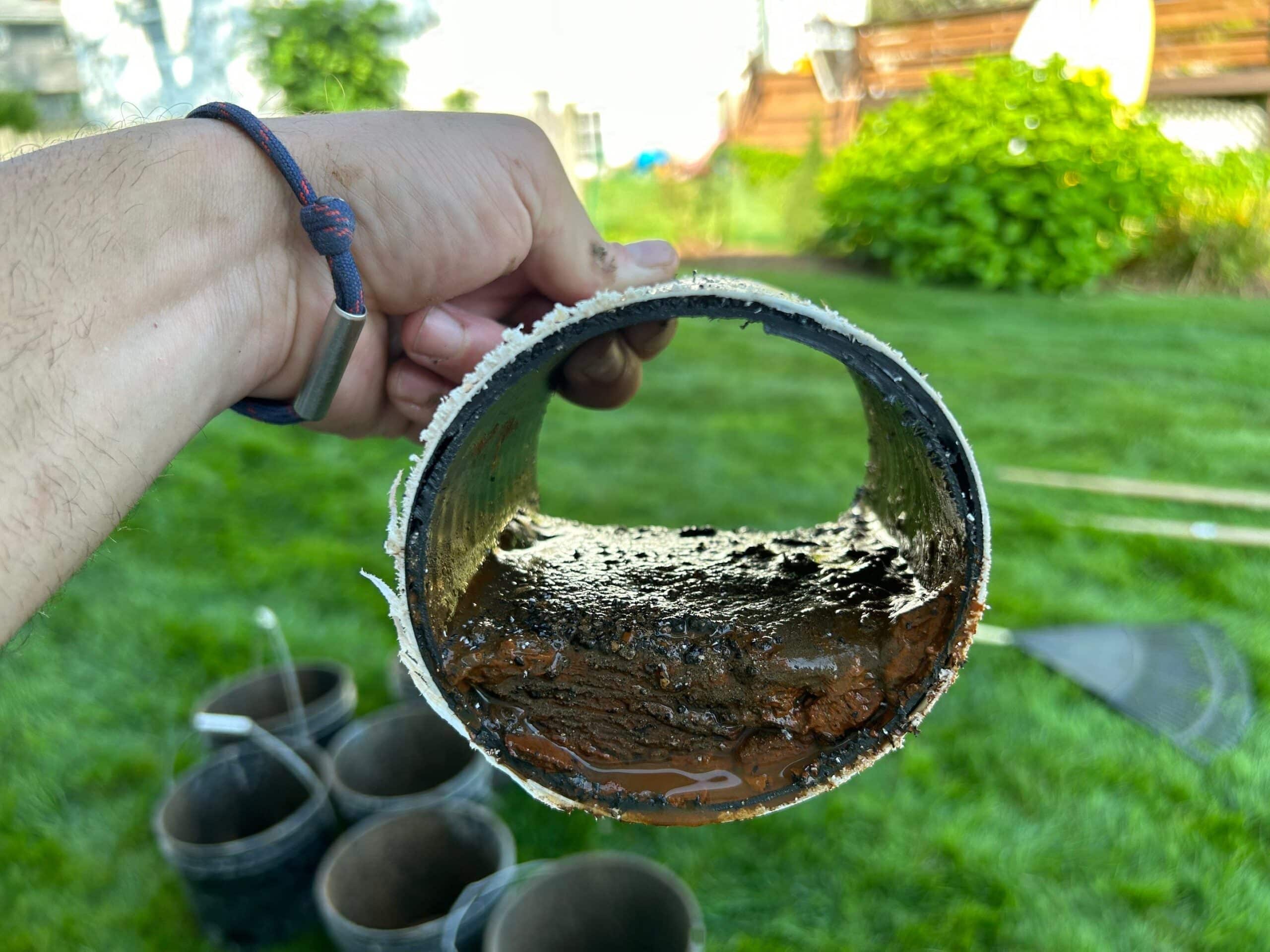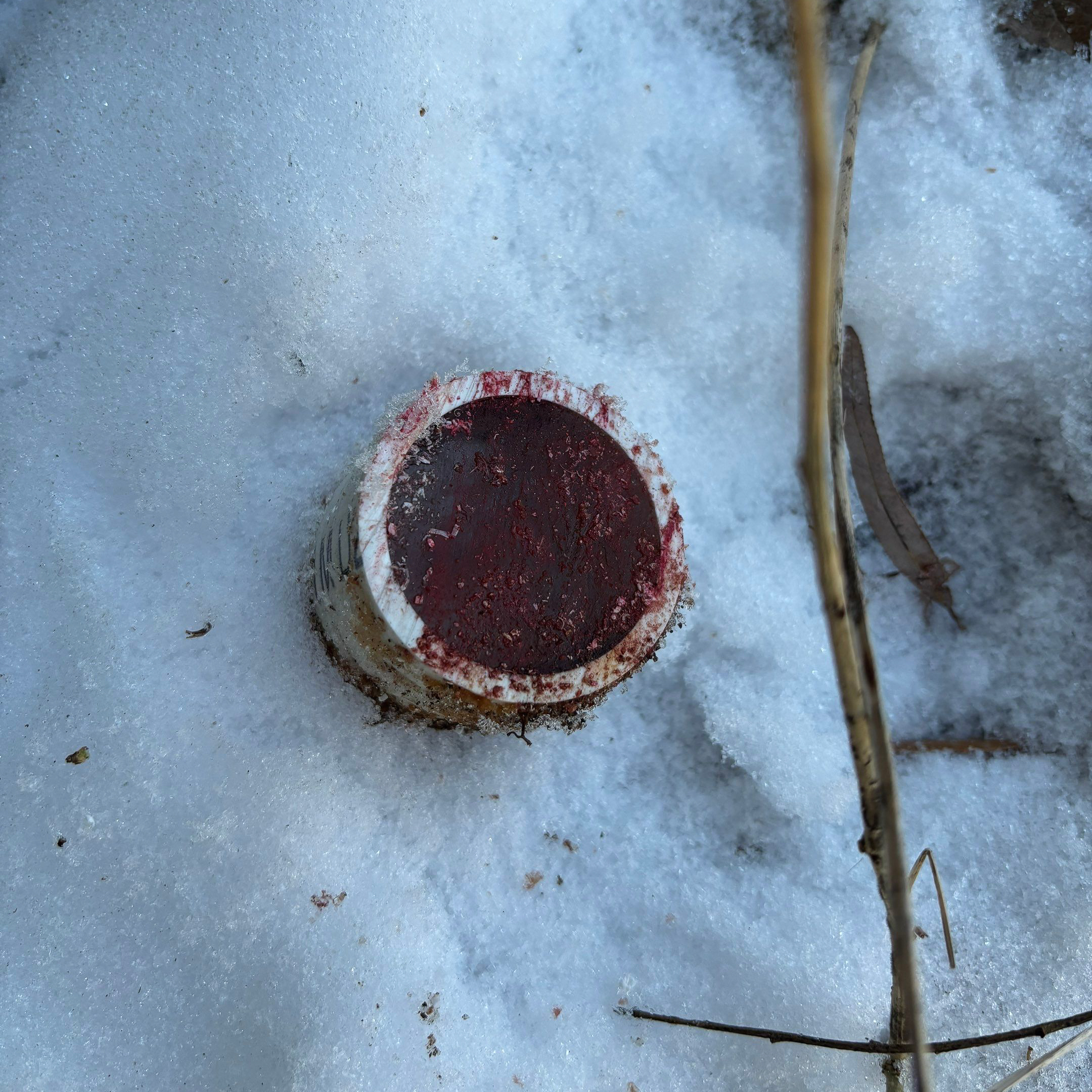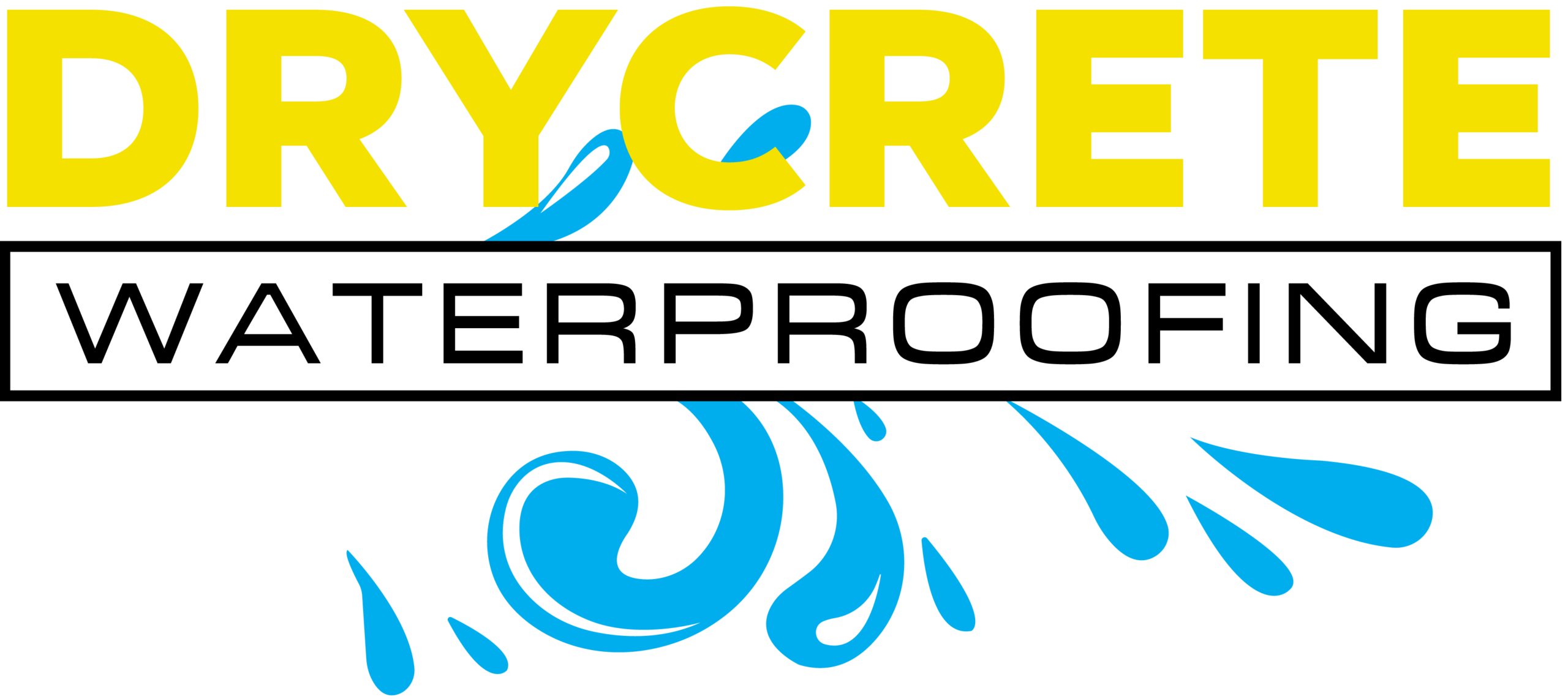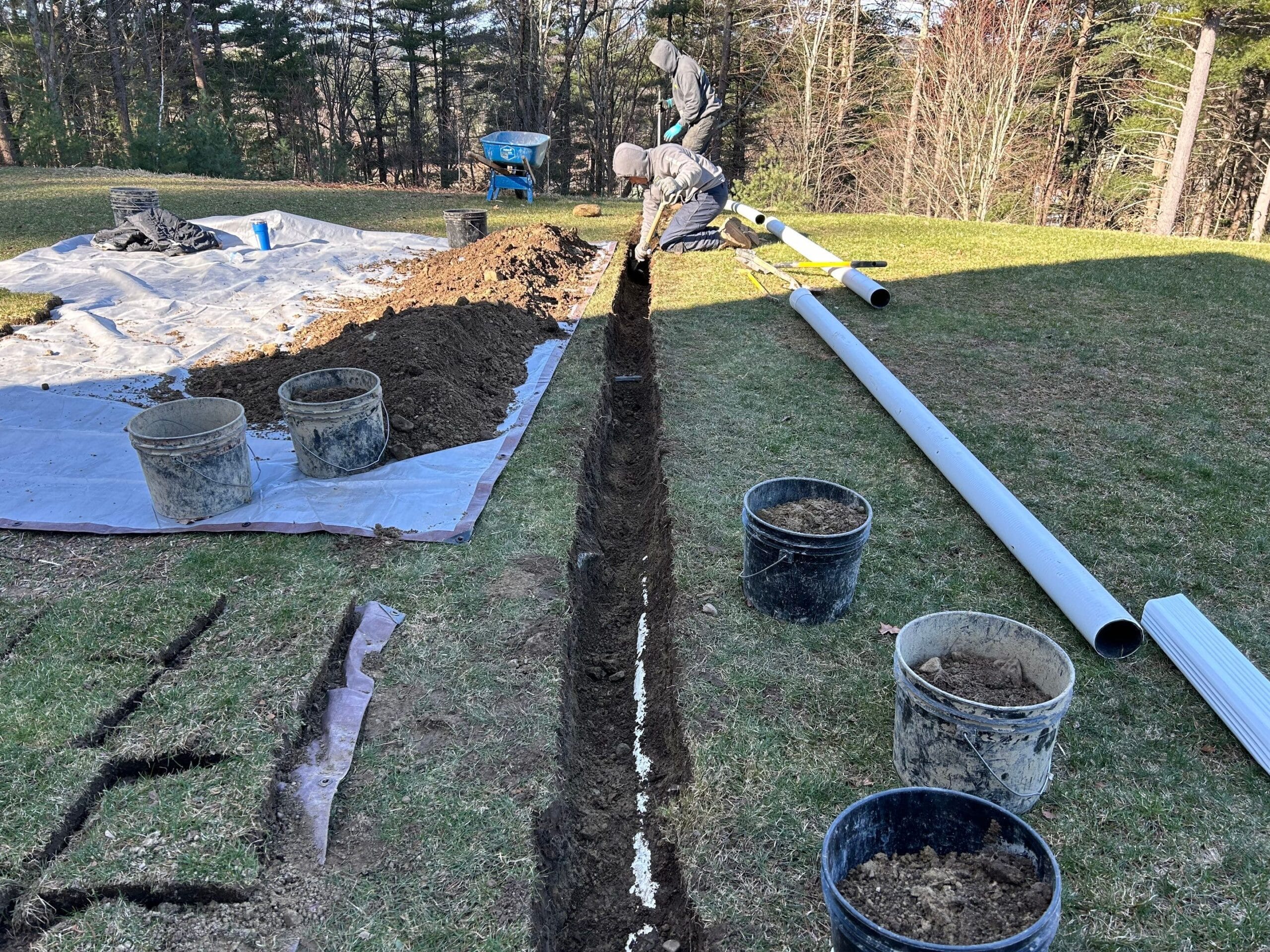While buried discharge pipes for both downspouts and sump pumps provide a clean and efficient way to move water away, problems with buried downspouts can still arise. Issues such as clogs, poor installation, root intrusion, and freezing can compromise their effectiveness. Below, we outline some of the most common problems with buried downspouts and sump pump discharge lines and how to address them.
1. Clogs and Blockages

The most common issue with underground downspouts and sump pump discharge lines is clogging. These blockages can occur due to accumulated leaves, dirt, debris, and even ice during colder months. While sump pump discharge lines primarily move groundwater, they can still become clogged with sediment, obstructed by small animal nests, or blocked by ice during winter.
Consequences
The primary function of downspout drainage and sump pump discharge lines is to direct water safely away from your home. Blockages in these underground systems can lead to water backing up and spilling out near your foundation, increasing the risk of basement flooding, soil erosion, and foundation damage. A clogged sump pump discharge line can also cause the pump to overwork, reducing its lifespan and potentially leading to pump failure.
Solutions
Preventing problems with buried downspouts and sump pump discharge lines starts with regular maintenance and proper installation. Clean your gutters and underground gutter drainage system at least twice a year to remove leaves, dirt, and debris that can lead to blockages. Installing gutter guards can help reduce the amount of material entering downspouts and minimize clog risks.
For sump pump discharge lines, ensure that the pipe is installed with a steady downward slope to prevent water from sitting inside, which can lead to sediment buildup or freezing. Use smooth-walled PVC or HDPE piping instead of corrugated pipe, as the ridges in corrugated pipes trap debris and slow drainage. In colder climates, extend the discharge pipe to daylight in a way that allows water to drain fully, reducing the risk of freeze-related clogs. Regularly inspect the discharge point to make sure water flows freely and does not pool near your foundation.
2. Bad Installation

Improper installation of underground downspouts and sump pump discharge lines can lead to major drainage issues. These pipes must be correctly sloped and properly terminated to function efficiently. Additionally, choosing the wrong type of discharge outlet can result in clogs, backups, and water pooling near your foundation.
Consequences
If downspout drainage and sump pump discharge lines are not installed with the correct slope (at least 1/8th inch per foot), water can become trapped inside, leading to stagnation, freezing, and backup. Improper outlet placement can also cause significant drainage failures.
- Daylighting the pipe (allowing it to discharge above ground at a slope) is the most reliable method, as it ensures water flows freely and allows for easy inspection and maintenance.
- Pop-up emitters can become buried under grass or debris over time if not maintained, blocking water flow and leading to system failure.
- Buried outlet points (such as discharging underground without a proper exit) are highly prone to clogs, as sediment, roots, and debris can block water flow, causing backups and potential flooding.
Another critical issue arises when discharge pipes are tied into drywells. While gutters can sometimes be directed into a properly sized drywell, sump pumps should never discharge into a drywell. Sump pumps move a large volume of water quickly, and drywells are not designed to handle this continuous surge. If a sump pump discharge line is directed into a drywell, the system will quickly overwhelm and back up, sending water right back toward the foundation.
Solutions
To avoid problems with buried downspouts and sump pump discharge lines:
- Ensure a proper slope (at least 1/8th inch per foot) to allow gravity-assisted drainage and prevent stagnant water.
- Use the right discharge outlet:
- Daylighting the pipe is always the best option for reliability and ease of maintenance.
- Avoid pop-up emitters unless you are committed to regular maintenance, as they can be buried under grass or debris.
- Never terminate discharge lines underground without a proper outlet, as they are prone to clogging.
- Do not tie sump pump discharge into a drywell. While gutter downspouts can sometimes connect to a drywell, the capacity must be large enough to handle high water volumes. If not properly sized, the drywell will overflow and defeat the purpose of the drainage system.
By ensuring proper pipe slope, selecting the right materials, and choosing an appropriate discharge method, you can prevent costly water damage and keep your underground drainage system functioning efficiently.
3. Root Intrusion
Both rain gutter underground drain and sump pump discharge pipes hold and transport significant amounts of water, which can attract nearby tree roots. Over time, roots can infiltrate and block the pipes, reducing water flow and causing leaks.
Consequences
Root intrusion can lead to pipe blockages, backups, and even structural damage to the piping system. If left unaddressed, this can cause significant water management issues, including foundation damage and excessive soil erosion. For sump pump discharge lines, root intrusion can restrict water flow, leading to back pressure on the pump and potential failure.
Solutions
Prevent root intrusion by:
- Keeping drainage pipes away from tree roots whenever possible.
- Using root-resistant materials such as HDPE.
- Installing root barriers around underground pipes to deter growth.
- Conducting periodic inspections to identify early signs of root invasion before it becomes a major issue.
4. Pipe Damage and Deterioration
Underground discharge lines, like any buried infrastructure, are subject to wear and tear. Factors such as soil shifting, heavy loads above the pipes, and the natural freeze-thaw cycle can cause cracks, breaks, or pipe separation over time.
Consequences
Damaged or deteriorating pipes can leak water into unintended areas, leading to pooling around the foundation, increased soil saturation, and potential basement seepage. If left unchecked, this can necessitate costly repairs. For sump pump discharge lines, pipe damage can cause leaks that prevent proper drainage, leading to frequent pump cycling and premature failure.
Solutions
Routine inspections and maintenance can help catch deterioration early. If replacement is needed, consider using durable, long-lasting materials such as PVC or HDPE pipes. Ensuring proper pipe bedding and backfilling during installation can also extend the lifespan of underground downspout and sump pump discharge lines.
5. Freezing in Cold Weather

In colder climates, standing water in downspout drainage and buried discharge lines can freeze, leading to blockages and pipe damage. Sump pump discharge lines are particularly vulnerable to freezing if not properly maintained.
Consequences
Frozen discharge lines can cause backups that lead to flooded basements and overworked sump pumps. Water expansion during freezing can also crack or break the pipes, leading to costly repairs in the spring. A frozen sump pump discharge line can completely disable the pump, rendering it useless when needed most.
Solutions
Preventing problems with buried downspouts and sump pump discharge lines from freezing requires proper installation and maintenance. Consider the following solutions:
- Ensure proper slope – Discharge pipes should have at least a 1/8-inch-per-foot slope to allow water to drain fully, minimizing the risk of standing water that can freeze.
- Extend sump pump discharge to daylight – The best way to prevent freezing is to run the discharge pipe to an above-ground outlet, allowing water to flow freely and preventing ice buildup inside buried sections.
- Avoid pop-up emitters in freezing climates – These can trap water and freeze solid, blocking the pipe completely. Instead, use a discharge that remains open to the air.
- Use larger-diameter pipes – A smooth-walled, larger-diameter pipe (such as 3” or 4” PVC) allows water to drain more efficiently and reduces the chance of freezing compared to smaller or corrugated pipes.
- Bury pipes below the frost line where possible – In areas with severe winters, pipes should be installed deep enough to stay below the frost line, preventing ice formation.
- Prevent discharge outlet blockages – Ensure that the end of the pipe remains unobstructed by snow, ice, or debris so that water can flow freely.
- Install an air gap relief system – A properly installed air gap or overflow outlet near the foundation allows excess water to escape if the main discharge line freezes, preventing sump pump failure.
How to Prevent These Problems
Proactive maintenance and proper installation are the best ways to prevent problems with buried downspouts and sump pump discharge lines. Key preventative measures include:
- Keeping gutters, downspout drainage, and sump pump discharge lines clean and clear.
- Regularly inspecting and flushing discharge lines to prevent buildup.
- Using high-quality, durable materials that resist root intrusion and freezing.
- Ensuring proper installation with adequate slope and appropriate termination points.
- Installing a backup sump pump or secondary discharge outlet to prevent failure due to freezing or blockages.
Working with professionals for installation and maintenance can help ensure your rain gutter underground drain system functions optimally for years to come. Investing in preventative measures now can save you from costly water damage repairs in the future.
The Best Way to Prevent Issues: Above-Ground Discharge
Whenever possible, above-ground discharge lines are the preferred method for sump pumps and downspouts. This setup eliminates many of the problems associated with underground drainage, such as clogs, freezing, and poor termination. By allowing water to discharge freely at the surface, above-ground systems are easier to monitor, maintain, and repair, reducing the risk of costly damage to your foundation.
Working with professionals for installation and maintenance can help ensure your rain gutter underground drain system functions optimally for years to come. Investing in preventative measures now can save you from expensive repairs and protect your home from water damage.

